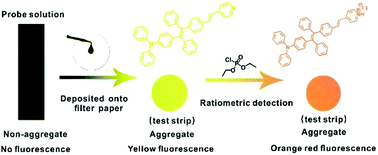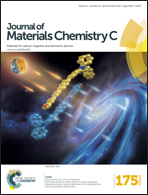Handy ratiometric detection of gaseous nerve agents with AIE-fluorophore-based solid test strips†
Abstract
Exposure to odorless, colorless, tasteless and yet lethal nerve gases could lead to paralysis of the central nervous system, organ failure or even rapid death. Hence it is of great importance to develop a convenient, portable and rapid detection method for these gaseous nerve agents. Herein, based on the aggregation-induced emission (AIE) characteristics, a ratiometric fluorescent test-strip sensor (DPA-TPE-Py) for rapid, sensitive and selective detection of the gaseous nerve agent simulant diethyl chlorophosphate (DCP) has been developed. It is easy to prepare handy and portable solid test strips via direct deposition of AIE probes onto the filter paper. Moreover, when the test strips are exposed to DCP vapor, their fluorescence changes from yellow to orange red. The detection limit for DCP is as low as 1.82 ppb, lower than the reported Immediately Dangerous to Life or Health concentration (IDLH concentration). Such a strategy could provide helpful insights into designing convenient cost-effective ratiometric fluorescent sensors in the solid state as well as affording a portative method for detection of gaseous nerve agents.


 Please wait while we load your content...
Please wait while we load your content...